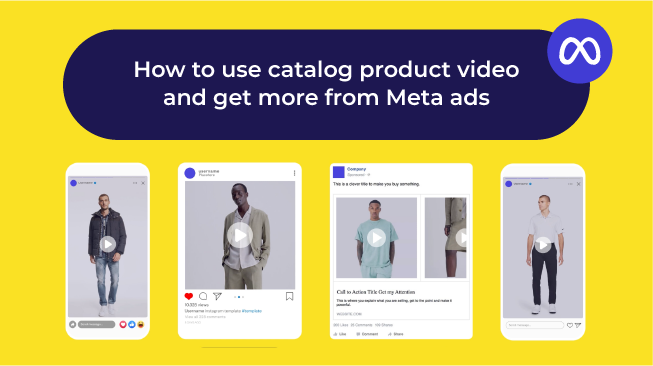Your dynamic ads are about to drop in performance, and here’s why. With the continuous crackdown on consumer data privacy, it’s becoming increasingly harder to attain the customer data that marketers need to optimise ads. Therefore, it is essential for e-commerce retailers to invest in an additional source of information: product performance data.
This article will go over data protection in the US and EU, cover the changes to consumer data privacy from Apple and Google, and discuss in detail how product performance data is necessary for marketers to adapt to data policy changes and how it works to enhance dynamic ads, so that digital marketing and data privacy can coexist moving forward.
Table of Contents
Data protection in online marketing
Data regulation and GDPR in the EU
Consumer data policy changes from Apple and Google
Can digital marketing coexist with data privacy?
Does User Data Security Stand In The Way Of Marketing?
Data protection in online marketing
Data collection has become the day to day norm. Almost every service we use involves the collection and analysis of our personal data, which helps advertisers better target their ads. However, the use of customer data is proving to be a growing privacy concern for the public. In fact, according to Pew Research Center, 81% of Americans believe that the potential risks from data collection by companies outweigh the benefits.
As a response to growing privacy concerns, legislators have begun to crack down on platforms collecting, storing, and selling their consumers’ personal data.
I’m going to go over some of the recent and impending changes to data protection, but feel free to skip ahead to learn about using product performance data here.
Data regulation in the US
In the US, data protection is primarily regulated by each state and respective industries. California is currently leading the way for consumer data protection through its CCPA (California Consumer Privacy Act of 2018), which gives consumers more control over the personal information that businesses gather about them. The CCPA regulations also offer guidance on how businesses and policymakers can implement the law. It is by far the strictest data protection regulation in the United States to date.
Data regulation and GDPR in the EU

The introduction of GDPR (General Data Protection Regulation) in 2018 was a game changer for consumer data protection. GDPR is a set of laws regarding data protection and privacy in the EU (European Union) and the EEA (European Economic Area). It also addresses the transfer of personal data outside of the EU and EEA, further expanding its reach to any company that conducts business with the EU/EEA.
The purpose behind GDPR is to enhance individuals’ rights and control over their personal data while also simplifying regulatory enforcement for international business. With its vast reach, GDPR has had the greatest legislative impact on global data privacy protection.
Consumer data policy changes from Apple and Google
It’s not just legislators fighting for better customer privacy. 72% of consumers believe that businesses, not the government, are best equipped to protect their data. That’s why Apple and Google have joined policymakers in the race to instil stricter consumer data privacy policies by blocking third-party cookies and implementing an opt-in option for app tracking.
The blocking of third-party cookies in Safari

Digital marketers use cookies to gather data—like what websites your users have visited—to help them deliver the most relevant content to targeted audiences. Third-party cookies are used for digital advertising purposes and are created by domains (third parties) that are not the website that your consumers are visiting.
However, in 2020 Apple released a trailblazing update to its Safari Intelligent Tracking Prevention (ITP). ITP is the privacy feature that allows Apple’s web browser to block cookies and prevent advertisers from essentially spying on users’ online habits.
Due to this update, Safari now blocks all third-party cookies by default, making it much more difficult for advertisers to follow people around the web and effectively target their ads to specific audiences based upon user behaviour.
This update not only made ripples across the advertising world, but beat Google Chrome’s phasing out of third-party cookies by (a predicted) three years.
The iOS 14.5 update

In April 2021, Apple released another groundbreaking privacy change: the iOS 14.5 update. This update introduced new controls on the ways that apps can track people. For the first time, users need to actively opt-in to app tracking, granting people unprecedented control over how their online behaviour is monitored.
The change behind the iOS 14.5 update is about App Tracking Transparency and has to do with a string of numbers known as the identifier for advertisers (IDFA). Every iPhone comes with its own identifier that provides advertisers with aggregate data about your customers’ interests. Google also has its own version of the identifier on Android phones, known as the Google Advertising ID.
These identifiers allow advertisers to track user downloads, purchases, and clicks in their mobile apps. This data is then used by advertisers to show hyper-targeted personalised ads based on your consumers’ behaviour. It also lets advertisers know if they’re spending their advertising budgets efficiently.
But the fact that Apple users now need to consciously choose to opt-in to app tracking adds another layer of difficulty for marketers. According to Statista, the app tracking opt-in rate is currently only around 21 percent. This is a huge loss of information for advertisers, who rely on this data to personalise their promos and create audience segments.
And to kick advertisers while they’re down, the new tracking restrictions from Apple aren't limited to an iPhone’s identifier. You also can’t track users using alternative identifiers, (e.g. their email address), and your apps can’t work differently or limit functions if a user does decide to opt-out of data tracking.
So with the iOS 14.5 update, when a user turns off app tracking, the only thing advertisers are able to see is a string of zeros. While this is awesome for Apple users’ privacy, it also greatly inhibits the extent to which marketers are able to personalise their ads.
Sunset of third-party cookies in Chrome
Google is joining in the privacy game as well, albeit quite a bit later. They’ve delayed their plans to phase out third-party cookies in the Chrome browser until 2023, a year later than originally expected. Other browsers like Firefox and Safari have already blocked third-party tracking cookies, but as Chrome makes up more than 56% of the global web browser market, the upcoming change to Chrome will hit the ad industry even harder. Some are even (dramatically) calling the impending sunset of Chrome’s third-party cookies, the “cookieapocalypse.”
Google announced that the reason behind the delay is “subject to our engagement with the United Kingdom’s Competition and Markets Authority (CMA).” This means that Google is (probably) buying themselves time to come up with new advertising technologies to replace third-party cookies.
Google, however, vows that once third-party cookies are phased out, they will not build alternate identifiers to track individuals as they browse the web, nor use them in their products, stating they believe alternate identifiers won’t meet rising consumer expectations for data privacy, nor will they stand up to rapidly changing regulatory restrictions.
While this is another great change for individual data privacy, it’s going to create immense challenges for the e-commerce advertisers that rely on consumer data.
Can digital marketing coexist with data privacy?
So with all of these changes to consumer privacy, can digital marketers survive? And if so, how?

To survive an evolving advertising world, advertisers need to adjust their digital marketing strategy to include the integration of product-level performance data and additional signals from other channels.
Does user data security stand In the way of marketing?
E-commerce marketers rely heavily on user data to create targeted ads, so yes, the privacy changes will take a toll.
The current foundation of data-driven marketing is based on better understanding and characterising of the individual user. Advertising platforms like Google and Meta identify their users’ interests and needs through their online behaviour (user data) and then match consumers to products based upon this behaviour, often before they even start looking to buy.
This system is known as discovery shopping and both major advertising platforms have their own versions: Meta Discovery Commerce and Google Discovery Ads.
Platform users add data to these smart ecosystems through apps and devices, and companies use, analyse, and capitalise on this information exceedingly fast, to better understand and predict customer behaviour and anticipate their desires. The better they know the user, the faster and easier advertisers can meet their needs.
But creating targeted ads based on user behaviour will soon be a thing of the past.
Once all major browsers have dropped third-party cookies, it will be near impossible for advertisers to set up audience targeting and frequency capping for 99% of users, and cross-site audience targeting will cease to exist.
Naturally, the trend of privacy-enhancing technology is causing advertisers to worry and has even started full-blown beef between internet giants. For example, when Apple announced their iOS 14.5 software update, Meta fought back, claiming that Apple was only acting out of “pure self-interest.” This little feud revealed Meta's growing concern over the significant effect Apple’s data privacy plans could have on its $84 billion a year ad revenue.
And rightfully so. The shift toward consumer data privacy is making it much harder for advertisers to get the user data they need to tailor their ads to the individual.
Due to the increase in tracking opt-outs and ad blockers, Google and Meta are undeniably losing signals, and without this information, the performance of retailers’ dynamic ads will surely drop.
While there are some workarounds to combat lost signals, such as Meta's CAPI (Conversions API) solution, it won’t be enough. Marketers need to start looking for additional data sources outside of user data now. That’s why it’s essential for e-commerce businesses to adapt to privacy changes by investing in a different type of data: product performance data.
Digital marketing and privacy: How can marketers adapt?

Marketers can adapt to the changing ad environment by investing in product performance data.
What is product performance data?
Right now, your marketing team already has access to your customer and campaign data, but neither of those offer insight into how each of your products are performing.
With product performance data, you can see the performance of each product through metrics such as margin, revenue, and number of transactions to determine your best-selling products, your low-performing products, and much more. Product performance data can also create a massive impact on your key performance metrics, like conversion volume and ROAS (return on ad spend).
And as data privacy policies continue to leave marketers at a loss for signals, product performance data is proving to be an increasingly important tool for e-commerce retail marketers to combat a drop in dynamic ad performance on Meta.
Why product performance data is the solution to privacy changes
Product performance data serves as a workaround to consumer data privacy. Traditionally, advertisers send signals connected to users through the following:
- Certain user identifiers (e.g. phone numbers or hashed emails)
- A timestamp of the event
- Event details (e.g. product IDs that were purchased)
But product performance data sidesteps the issue of consumer privacy by looking at the signals from a complementary angle and focusing on:
- Product identifiers (EAN, SKU, etc.)
- Business attributes of the product (margin, return rate, stock levels)
- Marketing product performance (CTR, conversion rate, ad spend, marketing channel)
- Product Trends (new arrivals, popularity, deadstock)
- Anomalies that can affect future performance (last variant of the size, low stock)
- Cross-channel data (e.g. to notice that a certain product is trending in Google Shopping, but the advertiser has low impression share due to an auction too pricey to reach the top positions)
By investing in product performance data, your marketing team will focus less energy on adhering to changing consumer data privacy policies.
Additionally, product performance data is highly beneficial for your dynamic ads. We found that Meta's algorithm focuses about 50% of all impressions on about 1% of the products in the catalogue. Most importantly, these products are not selected based on their revenue distribution or return on ad spend.
The reason this happens is because Meta uses your entire catalogue, rather than specific product sets, to select which items get promoted. The more Meta promotes one product, the more data they have on that one product, which causes them to continue to promote that one item, leaving your other items out of rotation.
To fix this vicious cycle and enhance dynamic ad algorithms, you can use your product performance data to create separate product sets with their own bids and budgets based around your specific goals. The social algorithms will then choose from the selected groups, rather than from the entire catalogue, making sure that all of the products you want to promote actually get promoted.
In addition, product performance data naturally leads to an improvement in the machine learning necessary for Meta Discovery Commerce, by offering insight into which products you should promote, which products you should stop promoting, and what your most popular channel for each product is.
The best way to enhance your campaigns with product performance data

We now know that product performance data is vital for marketers to adapt to the evolving e-commerce advertising world, but where do you find product performance data?
ROI Hunter, a Product Performance Management (PPM) platform, is the first of its kind. The PPM platform was created to connect e-commerce retailers to product performance data and enable them to use it effectively.
With the PPM platform, e-commerce businesses can collect product-level data (chance of return, margin, stock levels, etc.) from Meta, Google Ads, Google Analytics, and custom sources, and combine it, along with their product inventory, into a single source of truth. Retailers can then use these metrics to filter their catalogue, and create highly specific product sets for their goals.
To see the PPM platform in action, take a look at how KFC South Africa used the PPM platform to enhance their dynamic advertising campaign, resulting in a whopping 89% increase on their ROAS (return on ad spend).
You can also take a peek at how Sephora successfully used product performance data to create a bestseller product set that led to a 43% jump in ROI (return on investment). Pretty cool, I’d say.
And if you’re worried about data protection (which you should be, because it’s literally what this article is about), the PPM platform uses hashing algorithms as an added step for cyber security to ensure that no sensitive data (e.g. margins) are sent to Meta.
Takeaways
Concern for consumer data protection is growing. By hiding the customer data that marketers traditionally use for targeted ads, data privacy policies will continue to shake up the online advertising industry.
That’s why digital marketers need to start looking for additional data sources outside of user data, and product performance data through a PPM platform is the perfect solution. Product performance data sidesteps data privacy concerns as it is a complementary source of information that does not require user data. It also allows marketers to create specific product sets based on their goals, which increases control over dynamic advertising platforms’ algorithms. By capitalising on product data, digital marketers and data privacy policies can harmoniously coexist in the future.



.png)
